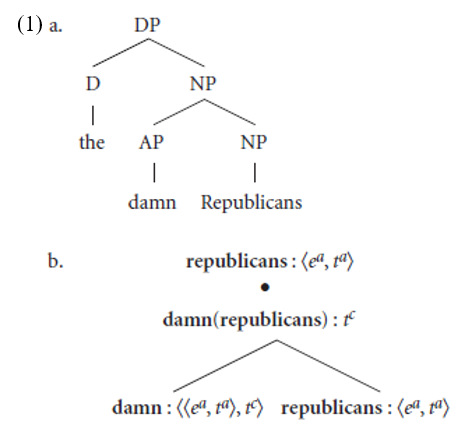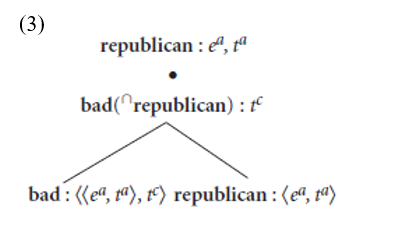


 Grammar
Grammar
 Tenses
Tenses
 Present
Present
 Past
Past
 Future
Future
 Parts Of Speech
Parts Of Speech
 Nouns
Nouns
 Verbs
Verbs
 Adverbs
Adverbs
 Adjectives
Adjectives
 Pronouns
Pronouns
 Pre Position
Pre Position
 Preposition by function
Preposition by function 
 Preposition by construction
Preposition by construction
 Conjunctions
Conjunctions
 Interjections
Interjections
 Grammar Rules
Grammar Rules
 Linguistics
Linguistics
 Semantics
Semantics
 Pragmatics
Pragmatics
 Reading Comprehension
Reading Comprehension| Potts 2005: Some theoretical machinery and damn expressive adjectives |
|
|
|
Read More
Date: 2024-01-19
Date: 7-3-2022
Date: 7-1-2022
|
Potts 2005: Some theoretical machinery and damn expressive adjectives
To serve as a foundation for an account, I will adopt the general framework of Potts (2005) for representing expressive meaning. In this framework, expressive meaning (conventional implicatures) and ordinary truth-conditional (“descriptive”) meaning are computed compositionally, in parallel, and along distinct dimensions of semantic representation.
Potts proposes an analysis of nonrestrictive adjectives that focuses on adjectives that lexicalize a nonrestrictive meaning, e.g., damn.1 In these representations, a syntactic tree such as the one in (1a) is understood to correspond to a semantic one, as in (1b), that represents its interpretation.

Importantly, the node in (1b) corresponding to damn Republicans has two tiers, divided by a bullet. The higher of these represents ordinary descriptive meaning. The lower represents expressive meaning. For each formula in (1b), its type is explicitly indicated to the right of the colon.
It is this type system that is the essence of how expressive meaning is represented. The core innovation is that (non-functional) types come in two flavors: one associated with an ordinary descriptive meaning (indicated with superscript a) and another with an expressive meaning (indicated with superscript c). A rule of semantic composition – CI Application2 – puts descriptive and expressive denotations together in the way (1b) reflects. This rule is roughly the expressive counterpart of the standard functional application rule. In (1b), then, the fact that damn contributes expressive meaning is reflected in its type. It is a function from ordinary properties (ea , ta ) to expressive truth values (tc), and thus applies to the denotation of Republicans to yield an expressive truth value. Because of how the CI Application rule works, the ordinary meaning of Republicans is simply passed on to damn Republicans, reflecting the fact that, apart from expressive meaning, these expressions are synonymous.
This of course reflects only how semantic composition proceeds. Substantively, Potts suggests that damn denotes a function that predicates of the kind correlate of its argument, specifically, that it denotes some kind of generalized disapproval predicate whose exact nature is irrelevant to the combinatorics, as in (2) (where ∩ is the nominalization function of Chierchia 1984, which maps a predicate to a corresponding kind, and Ù is an arbitrary type):

Very roughly, this says that damn is true of a property iff things that have that property are bad. Thus (2) could be spelled out more fully as (3):

1 He calls these “expressive” adjectives, using the term in a more narrow sense than I will here. He suggests, though, that analogous nonrestrictive uses of e.g. lovely work roughly similarly.
2 “CI” is for “conventional implicature.”
|
|
|
|
التوتر والسرطان.. علماء يحذرون من "صلة خطيرة"
|
|
|
|
|
|
|
مرآة السيارة: مدى دقة عكسها للصورة الصحيحة
|
|
|
|
|
|
|
نحو شراكة وطنية متكاملة.. الأمين العام للعتبة الحسينية يبحث مع وكيل وزارة الخارجية آفاق التعاون المؤسسي
|
|
|